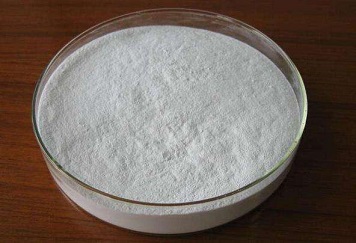Bariumcarbonat Chemische Eigenschaften,Einsatz,Produktion Methoden
ERSCHEINUNGSBILD
WEISSES, KRISTALLINES PULVER
CHEMISCHE GEFAHREN
Reagiert heftig mit starken S?uren. Reagiert heftig mit Bromtrifluorid unter Feuergefahr.
ARBEITSPLATZGRENZWERTE
TLV nicht festgelegt.
MAK nicht festgelegt.
AUFNAHMEWEGE
Aufnahme in den K?rper durch Verschlucken.
INHALATIONSGEFAHREN
Eine gesundheitssch?dliche Partikelkonzentration in der Luft kann schnell erreicht werden, vor allem als Pulver.
WIRKUNGEN BEI KURZZEITEXPOSITION
WIRKUNGEN BEI KURZZEITEXPOSITION: Kann mechanische Reizungen verursachen. Exposition kann zu Hypokalaemia führen, mit nachfolgenden muskul?ren und Herzfunktionsst?rungen bei Verschlucken in hohen Dosen.
LECKAGE
Pers?nliche Schutzausrüstung: Atemschutzger?t, P2-Filter für sch?dliche Partikel. Verschüttetes Material in Beh?ltern sammeln. Reste sorgf?ltig sammeln. An sicheren Ort bringen.
R-S?tze Betriebsanweisung:
R22:Gesundheitssch?dlich beim Verschlucken.
S-S?tze Betriebsanweisung:
S24/25:Berührung mit den Augen und der Haut vermeiden.
Beschreibung
Barium carbonate has the molecular formula of
BaCO
3 and the molecular weight of 197.3359 g/mol. Its
CAS number is 513-77-9. Barium carbonate has only
one stable form (aragonite-type structure) and temperature
of precipitation has no effect on crystal form, unlike
that of calcium or magnesium carbonates.
Chemische Eigenschaften
Barium carbonate, BaCO3, also known as witherite, is a white powder that is soluble in acids,with the exception of sulfuric acid.It has a melting point of 174°C and is used in television picture tubes, rodenticide, optical glass and ceramic flux.

Barium oxide, BaO, is manufactured by decomposition of barium carbonate.
Physikalische Eigenschaften
White powder; orthorhombic crystal system; density 4.286 g/cm3; refractive index 1.60; hardness 3.50 Mohs; melts at 811°C; insoluble in water (c. 25 mg/L at 25°C); Ksp 2.0 x 10-9.
Occurrence
Barium carbonate is found in nature as mineral witherite. The compound has many major commercial applications in brick, glass, ceramics, oil-drilling, photographic and chemical industries. It is mixed with wet clay to immobilize many water-soluble salts in making uniform red bricks. In the glass industry, barium is added to glass as barium carbonate or barium oxide to improve the refractive index of optical glass; also to promote sintering and lower the viscosity of melted glass to make glass bead formation easy. It is used in the manufacture of television picture tubes and photographic paper. Another important application involves its use as a fluxing ingredient in ceramic industry for enamels, glazes and ceramic bodies. Barium carbonate is used in oil-well drilling to insolubilize gypsum and inhibit coagulation; in ferrous metallurgy for steel carburizing; in chlor-alkali cells for treating salt brines to remove sulfates; and to make ferrite, and barium titanate. Many barium salts are prepared from barium carbonate.
Verwenden
Barium carbonate has many major commercial applications
in brick, glass, ceramics, oil-drilling, photographic
and chemical industries. It is mixed with wet clay to
immobilize many water-soluble salts in making uniform
red bricks. In the glass industry, barium is added to glass
as barium carbonate or barium oxide to improve the
refractive index of optical glass and also to promote sintering
and lower the viscosity of melted glass to make
glass bead formation easy. It is used in the manufacture
of television picture tubes and photographic paper.
Another important application involves its use as a fluxing
ingredient in ceramic industry for enamels, glazes
and ceramic bodies. Barium carbonate is used in oil
well drilling to insolubilize gypsum and inhibit coagulation;
in ferrous metallurgy for steel carburizing; in chloralkali
cells for treating salt brines to remove sulfates; and
to make ferrites, and barium titanate. Many barium salts
are prepared from barium carbonate.
Definition
barium carbonate: A white insolublecompound, BaCO
3; r.d. 4.43. It decomposeson heating to give bariumoxide and carbon dioxide:
BaCO
3(s) → BaO
(s) + CO
2(g)The compound occurs naturally asthe mineral witherite and can be preparedby adding an alkaline solutionof a carbonate to a solution of a bariumsalt. It is used as a raw materialfor making other barium salts, as aflux for ceramics, and as a raw materialin the manufacture of certaintypes of optical glass.
synthetische
Barium
carbonate is made commercially from barium sulfide
either by treatment with sodium carbonate or ammonium
carbonate at 60 to 70°C or by passing CO2 gas
through a soluble Ba
2+
solution at 40 to 90°C.
Allgemeine Beschreibung
Barium carbonate is a white powder. Barium carbonate is insoluble in water and soluble in most acids, with the exception of sulfuric acid. Barium carbonate has a specific gravity of 4.275. Barium carbonate is toxic by ingestion.
Air & Water Reaktionen
Barium carbonate is insoluble in water and soluble in most acids, with the exception of sulfuric acid.
Reaktivit?t anzeigen
Salts, basic, such as Barium carbonate, are generally soluble in water. The resulting solutions contain moderate concentrations of hydroxide ions and have pH's greater than 7.0. They react as bases to neutralize acids. These neutralizations generate heat, but less or far less than is generated by neutralization of the bases in reactivity group 10 (Bases) and the neutralization of amines. They usually do not react as either oxidizing agents or reducing agents but such behavior is not impossible.
Hazard
A poison.
Health Hazard
(INGESTION ONLY): excessive salivation, vomiting, severe abdominal pain, and violent purging with watery and bloody stools; a slow and often irregular pulse and a transient elevation in arterial blood pressure; tinnitus, giddiness and vertigo; muscle twitchings, progressing to convulsions and/or paralysis; dilated pupils with impaired accommodation; confusion and increasing somnolence, without coma; collapse and death from respiratory failure and cardiac arrest.
Brandgefahr
Non-combustible, substance itself does not burn but may decompose upon heating to produce corrosive and/or toxic fumes. Some are oxidizers and may ignite combustibles (wood, paper, oil, clothing, etc.). Contact with metals may evolve flammable hydrogen gas. Containers may explode when heated.
Sicherheitsprofil
Poison by ingestion,
intravenous, and intraperitoneal routes.
Human systemic effects by ingestion:
stomach ulcers, muscle weakness,
paresthesias and paralysis, hypermotility,
diarrhea, nausea or vomiting, lung changes.
Experimental reproductive effects.
Incompatible with BrF3 and 2-
furanpercarboxylic acid. See also BARIUM
COMPOUNDS (soluble).
Bariumcarbonat Upstream-Materialien And Downstream Produkte
Upstream-Materialien
Downstream Produkte

